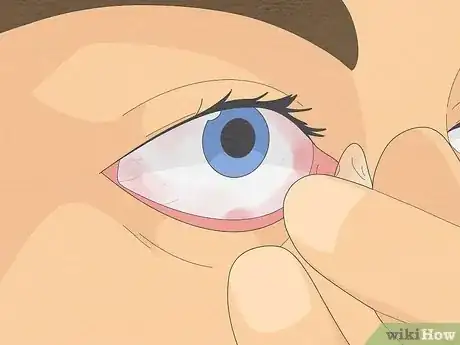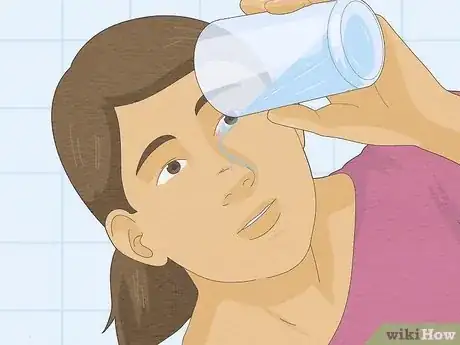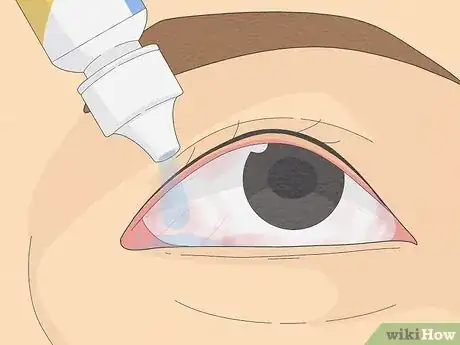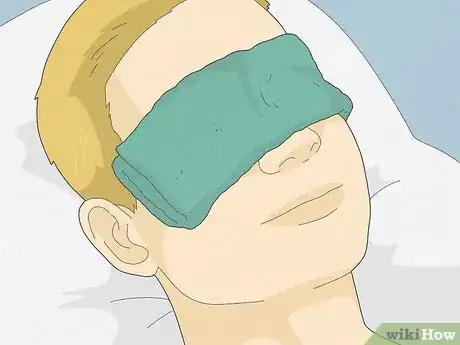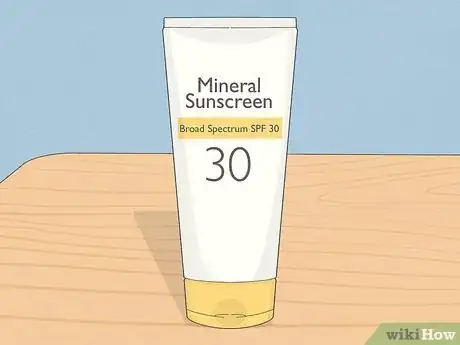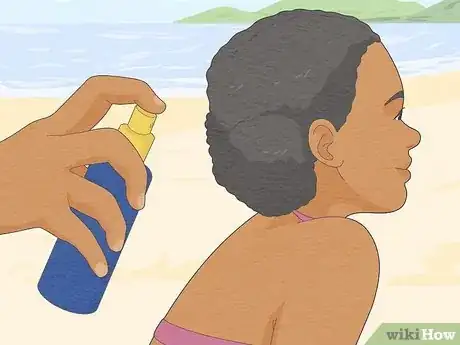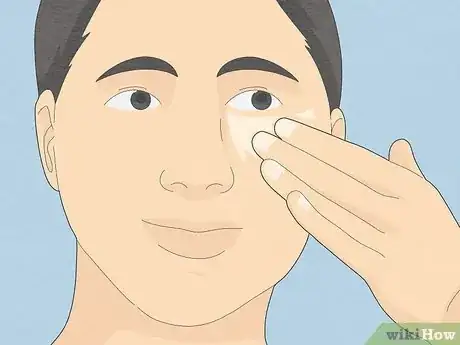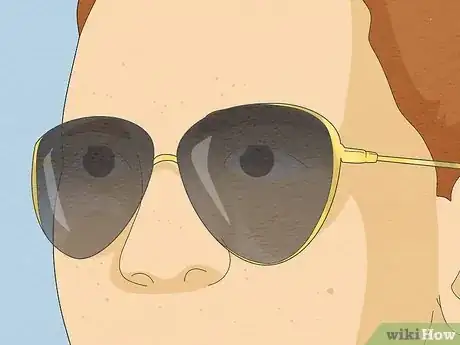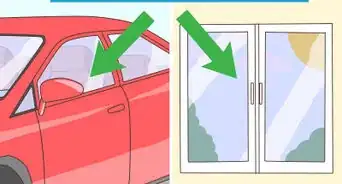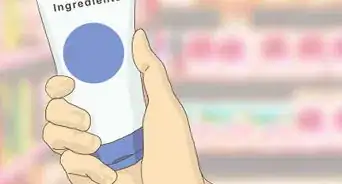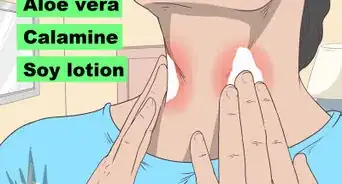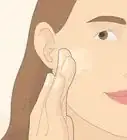This article was co-authored by Kelly Chu and by wikiHow staff writer, Luke Smith, MFA. Kelly is the lead makeup artist and educator of the Soyi Makeup and Hair team that is based in the San Francisco Bay Area. Soyi Makeup and Hair specializes in wedding and event makeup and hair. Over the past 5 years, the team has created bridal looks for over 800 brides in America, Asia, and Europe.
There are 8 references cited in this article, which can be found at the bottom of the page.
A little sunscreen in the eyes happens to the best of us, but that doesn’t mean it stings any less. Hang in there, because we’re here to get you out of this mess (and to get this mess out of your eyes). If you can, keep those lids open long enough to read our simple guide on how to remove sunscreen from your eyes or someone else’s, and how to prevent this from happening again on your next beach day.
Things You Should Know
- Wash your hands with warm water and soap, and remove your contacts as soon as possible.
- Position your face beneath a faucet and let a warm, gentle stream of water flow over your eyes, or pour water from a clean glass into your eyes as you tip your head back.
- Calm and comfort a small child with sunscreen in their eyes while you tilt their head back and gently pour a glass of water or eye drops into the inner corner of their eye.
- Use mineral-formula sunscreen or sunscreen stick around your eyes, wear sunglass, and help small children apply sunscreen to prevent further problems.
Steps
Flushing Your Eyes
-
1Wash your hands, if possible, and keep them away from your eyes. Your instinct will be to rub the sunscreen out of your eyes in order to get something out of them, but remember, there’s still sunscreen on your fingers! If possible, wash your hands with soap and warm water before you go any further.[1] A thorough rinse will do if you don’t have soap on-hand.
- If you’re helping someone else remove sunscreen from their eyes, reassure them with a soothing voice and move them to a well-lit spot, seating them in a position that gives you easy access to their face.
-
2Remove your contacts, if you wear them. With clean hands, take out your contacts and place them somewhere safe, so you can rinse them off in contact solution later. Contacts aren’t doing this situation any favors—the sunscreen may have worked its way between them and your eyes, worsening the problem.[2]Advertisement
-
3Rinse your eyes with warm water under a running faucet for 15 minutes. In a bathroom, set a faucet to a gentle flow of lukewarm water. Bend over and position your eye under the faucet, turning your head as necessary. Let the water flow across your face so that it passes over your eye, and hold your eye open to rinse it. Continue to do so for about 15 minutes, to completely flush the sunscreen from your eye.[3]
- Alternatively, step into the shower. Then, with your face tilted toward the shower head, let a gentle stream of warm water flow from your forehead down into your held-open eye.
-
4Pour warm water over your open eyes if you don't have faucet access. Use a clean cup filled with warm water to rinse the eyes. With your head tilted back, rest the edge of the cup on the bone just beneath your eye. Then gently tilt the cup to spill water into your eye socket, holding your eye open with your free hand.[4]
-
5Alternatively, apply eye drops to the inner corner of your eye. Squeeze a few drops, then do your best to open your eye, blinking rapidly to allow the liquid to rinse the surface of your eye. Use mild, moisturizing eye drops—avoid any that say “super cleaning” on the label or include hydrogen peroxide on their ingredients list, as these can further harm and already irritated eye.[5]
- Use eye drops in addition to warm water to better flush your eye, restore moisture, and soothe irritation after the first rinse.
-
6Rest your eyes for 15-30 minutes. Move to a shady or dim area and keep your eyes closed for a while. Your eyes have just been through a lot and are most likely reddened and still a bit irritated, and will need a chance to recover.[6] Wet a wash cloth with cold water and lay it over your eyes to help relieve some pain as you recover.
- If your eyes still sting after a few hours, contact emergency services for help. If you’re helping someone else, have them tell you how they’re feeling every so often.
Prevention
-
1Spray sunscreen on your hands, not your face. It’s so tempting to just aim and spray, we know, but that’s a recipe for disaster. Instead, spray that sunscreen into your hands, give it a few rubs, then apply it to your face with your fingers, This allows for more deliberate application.[7] In addition, stick sunscreens also allow for easier application that lessens the chance of eye irritation.[8]
-
2Use mineral-formula sunscreen around your eyes. Mineral-based sunscreens, also known as physical sunscreens, such as those made with zinc or titanium dioxide, are generally more gentle on the skin and accordingly, won’t irritate your eyes as much if they happen to find their way in.[9]
-
3Help small children apply sunscreen, and keep it out of their reach. Kids aren’t the best at thorough and proper sunscreen application (and you can’t really blame them). Their little hands are more likely to deposit a glob of sunscreen right into their eyes. To avert this, help your kid with sunscreen application, and teach them to be careful around their eyes as you do.[10]
- Also, keep your sunscreen on a high shelf or locked cabinet, where they’re unlikely to find and use it unsupervised.
-
4Rub the sunscreen in completely. This serves a dual purpose: first, it ensures that the sunscreen is completely absorbed and can more effectively protect you from UV rays.[11] As an added bonus, thoroughly rubbing the sunscreen into your skin ensures that no stray or excess sunscreen can slide into your eyes as you go about your day.
-
5Wear sunglasses for added protection. Of course, it’s important to protect your thinnest, most sensitive skin (like the area around your eyes) from harmful UV rays, but you can take some pressure off the sunscreen situation by wearing large, dark sunglasses, as well. Top it off with a wide-brimmed hat to stay cool and safe on your sunny days outside.[12]
References
- ↑ https://www.mayoclinic.org/first-aid/first-aid/basics/art-20056645
- ↑ https://health.clevelandclinic.org/how-to-flush-out-your-eye/
- ↑ https://www.mayoclinic.org/first-aid/first-aid/basics/art-20056645
- ↑ https://www.mayoclinic.org/first-aid/first-aid/basics/art-20056645
- ↑ https://health.clevelandclinic.org/how-to-flush-out-your-eye/
- ↑ https://www.poison.org/articles/ouch-that-stuff-got-in-my-eye
- ↑ https://www.aad.org/public/everyday-care/sun-protection/shade-clothing-sunscreen/how-to-use-stick-spray-sunscreens
- ↑ https://www.skincancer.org/blog/sunscreen-around-your-eyes/
- ↑ https://www.skincancer.org/blog/sunscreen-around-your-eyes/
- ↑ https://kidshealth.org/en/parents/sunscreen.html
- ↑ https://www.aad.org/public/everyday-care/sun-protection/shade-clothing-sunscreen/how-to-apply-sunscreen
- ↑ https://www.npr.org/sections/health-shots/2019/04/03/709486490/you-missed-a-spot-patchy-sunscreen-application-leaves-skin-vulnerable-to-cancer

